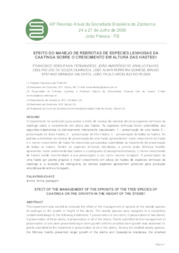Efeito do manejo de rebrotas de espécies lenhosas da Caatinga sobre o crescimento em altura das hastes.
Efeito do manejo de rebrotas de espécies lenhosas da Caatinga sobre o crescimento em altura das hastes.
Author(s): FERNANDES, F. E. P.; ARAUJO FILHO, J. A. de; OLIVINDO, C. de S.; GOMES, J. A. F.; VALENTE, B. S. M.; REGO, J. P. A do
Summary: Resumo: O experimento foi conduzido para avaliar o efeito do manejo de rebrotas de cinco espécies lenhosas da caatinga sobre o crescimento em altura das hastes. As espécies lenhosas foram submetidas aos seguintes tratamentos no delineamento inteiramente casualizado: 1 - preservação de uma haste; 2 - preservação de duas hastes; 3 - preservação de três hastes; 4 - preservação de todas as hastes. As plantas submetidas ao manejo de preservação de uma haste apresentaram maior crescimento de haste e o menor crescimento de haste foi observado para plantas submetidas ao tratamento de preservação de todas as hastes. Dentre as espécies lenhosas estudadas, a jurema preta (Mimosa hostilis) apresentou maior crescimento das hastes e a catingueira (Caesalpinia bracteosa), o menor crescimento de hastes sendo recomendada a sua preservação e uso como recurso forrageiro. A preservação de uma haste por planta propicia o maior crescimento em altura de hastes de espécies lenhosas da caatinga e, a exceção da catingueira, as demais espécies apresentam potencial para produção simultânea de lenha e forragem. [Effect of the management of the sprouts of the tree species of caating on the growth in the height of the stems]. Abstract - The experiment was carried to evaluate the effect of the management of sprouts of five woody species of caatinga on the growth in height of the stems. The woody species were assigned to a completely randomized design to the following treatments: 1-preservation of one stem; 2-preservation of two stems; 3-preservation of three stems; 4-preservation of all of the stems. Plants submitted to the management of preservation of one stem presented larger stem growth and the smallest stem growth was observed for plants submitted to the treatment of preservation of all of the stems. Among the studied woody species, the Mimosa hostilis presented larger growth of the stems and Caesalpinia bracteosa, the smallest growth of stems being recommended to preservation and use as resource forage. The preservation of one stem for plant propitiates the largest growth in height of stems of woody species of caatinga and, the exception of the Caesalpinia bracteosa, the other species present potential for simultaneous production of firewood and forage.
Publication year: 2006
Types of publication: Paper in annals and proceedings
Unit: Embrapa Goats & Sheep
Keywords: Brasil, Brazil, Caatinga, Caesalpinia bracteosa, Catingueira, Ceará, Espécie lenhosa, Firewood, Haste, Jurema Preta, Lenha, Mimosa Hostilis, Pastagem, Rebrota, Regrowth, Semiarid zones, Semiárido, Trees, Wood
Observation
Some of Embrapa's publications are published as ePub files. To read them, use or download one of the following free software options to your computer or mobile device. Android: Google Play Books; IOS: iBooks; Windows and Linux: Calibre.
Access other publications
Access the Agricultural Research Database (BDPA) to consult Embrapa's full library collection and records.
Visit Embrapa Bookstore to purchase books and other publications sold by Embrapa.

